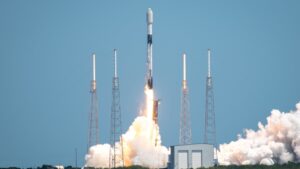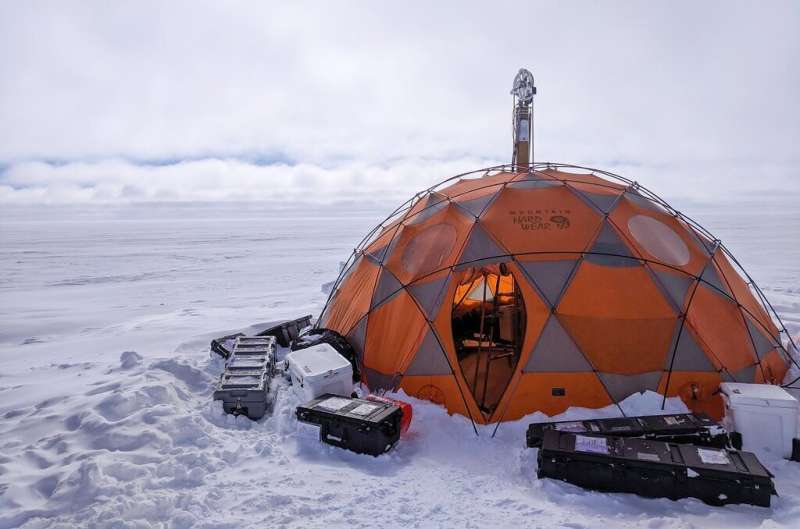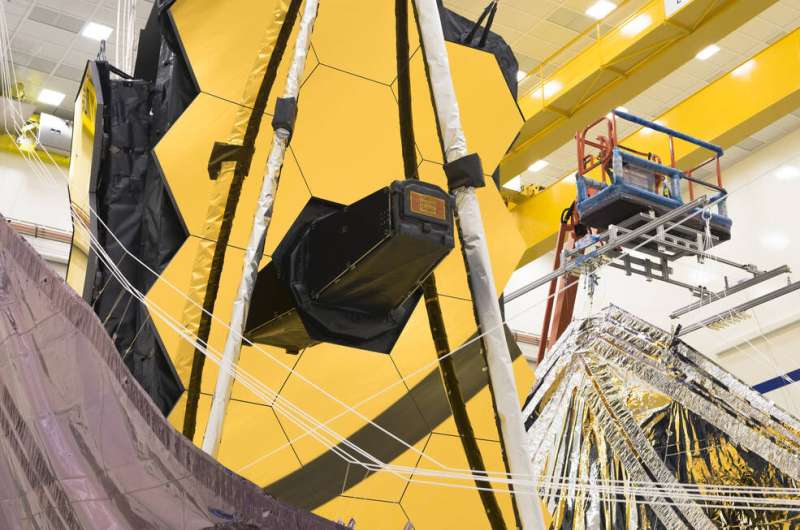Webb Telescope packs its sunshield for a million mile trip
Wednesday, 07 April 2021 09:31 Engineers working on NASA's James Webb Space Telescope have successfully folded and packed its sunshield for its upcoming million-mile (roughly 1.5 million kilometer) journey, which begins later this year. The sunshield - a five-layer, diamond-shaped structure the size of a tennis court - was specially engineered to fold up around the two sides of the telescope and fit within the confines of its
Engineers working on NASA's James Webb Space Telescope have successfully folded and packed its sunshield for its upcoming million-mile (roughly 1.5 million kilometer) journey, which begins later this year. The sunshield - a five-layer, diamond-shaped structure the size of a tennis court - was specially engineered to fold up around the two sides of the telescope and fit within the confines of its Ningbo to build $3.05b rocket launchpad site
Wednesday, 07 April 2021 09:31 The port city of Ningbo in Zhejiang province is building a 20 billion yuan ($3.05 billion) rocket launch site to meet surging demand for putting satellites into orbit and further develop the industrial cluster of the commercial aerospace sector, according to the local authorities.
Highlighted in the recently revealed draft for mega projects in Zhejiang during the 14th Five-Year Plan period
The port city of Ningbo in Zhejiang province is building a 20 billion yuan ($3.05 billion) rocket launch site to meet surging demand for putting satellites into orbit and further develop the industrial cluster of the commercial aerospace sector, according to the local authorities.
Highlighted in the recently revealed draft for mega projects in Zhejiang during the 14th Five-Year Plan period Mars helicopter Ingenuity performs well before first flight
Wednesday, 07 April 2021 09:31 NASA's Mars helicopter Ingenuity, the first powered aircraft on another planet, is free of the Perseverance rover that carried it and appears to be functioning well ahead of its first flight on Sunday, the space agency said.
NASA plans to broadcast the results of that first flight at 3:30 a.m. EDT Monday after the helicopter transmits data and images to Perseverance, which will send the
NASA's Mars helicopter Ingenuity, the first powered aircraft on another planet, is free of the Perseverance rover that carried it and appears to be functioning well ahead of its first flight on Sunday, the space agency said.
NASA plans to broadcast the results of that first flight at 3:30 a.m. EDT Monday after the helicopter transmits data and images to Perseverance, which will send the China's Chang'e 4 probe resumes work for 29th lunar day
Wednesday, 07 April 2021 09:31 The lander and rover of the Chang'e 4 probe have resumed work for a 29th lunar day on the far side of the moon.
The lander woke up at 9:43 pm Tuesday (Beijing Time), and the rover, Yutu-2 (Jade Rabbit-2), awoke at 3:54 am Tuesday, according to the Lunar Exploration and Space Program Center of the China National Space Administration.
The Chang'e 4 probe, switching to dormant mode duri
The lander and rover of the Chang'e 4 probe have resumed work for a 29th lunar day on the far side of the moon.
The lander woke up at 9:43 pm Tuesday (Beijing Time), and the rover, Yutu-2 (Jade Rabbit-2), awoke at 3:54 am Tuesday, according to the Lunar Exploration and Space Program Center of the China National Space Administration.
The Chang'e 4 probe, switching to dormant mode duri Asteroids are born big - and here is why!
Wednesday, 07 April 2021 09:31 Why do asteroids in the solar system have the sizes we observe? Two researchers at the Max Planck Institute for Astronomy have found an answer to that fundamental question: For the birth planets and planet precursors in our solar system 4.5 billion years ago, turbulence played a key role, helping to bring together pebble-like objects to form larger aggregations known as planetesimals. The presen
Why do asteroids in the solar system have the sizes we observe? Two researchers at the Max Planck Institute for Astronomy have found an answer to that fundamental question: For the birth planets and planet precursors in our solar system 4.5 billion years ago, turbulence played a key role, helping to bring together pebble-like objects to form larger aggregations known as planetesimals. The presen Trio of fast-spinning brown dwarfs may reveal a rotational speed limit
Wednesday, 07 April 2021 09:31 Using data from NASA's Spitzer Space Telescope, scientists have identified the three fastest-spinning brown dwarfs ever found. More massive than most planets but not quite heavy enough to ignite like stars, brown dwarfs are cosmic in-betweeners. And though they aren't as well known as stars and planets to most people, they are thought to number in the billions in our galaxy.
In a study app
Using data from NASA's Spitzer Space Telescope, scientists have identified the three fastest-spinning brown dwarfs ever found. More massive than most planets but not quite heavy enough to ignite like stars, brown dwarfs are cosmic in-betweeners. And though they aren't as well known as stars and planets to most people, they are thought to number in the billions in our galaxy.
In a study app First transiting exoplanet's 'chemical fingerprint' reveals its distant birthplace
Wednesday, 07 April 2021 09:31 Astronomers have found evidence that the first exoplanet that was identified transiting its star could have migrated to a close orbit with its star from its original birthplace further away. Analysis of the planet's atmosphere by a team including University of Warwick scientists has identified the chemical fingerprint of a planet that formed much further away from its sun than it currently resid
Astronomers have found evidence that the first exoplanet that was identified transiting its star could have migrated to a close orbit with its star from its original birthplace further away. Analysis of the planet's atmosphere by a team including University of Warwick scientists has identified the chemical fingerprint of a planet that formed much further away from its sun than it currently resid SKF bearings help Mars Rover collect rock and regolith samples on the planet's surface
Wednesday, 07 April 2021 09:31 Enabling the Mars Rover's core operations in the harsh environment on Mars are Kaydon RealiSlim thin-section ball bearings, designed and manufactured by SKF at the company's global thin-section bearing engineering center in Muskegon, and its recently expanded manufacturing hub in Sumter, USA.
These highly engineered components contribute to the survival of the rover's main robotic arm, sam
Enabling the Mars Rover's core operations in the harsh environment on Mars are Kaydon RealiSlim thin-section ball bearings, designed and manufactured by SKF at the company's global thin-section bearing engineering center in Muskegon, and its recently expanded manufacturing hub in Sumter, USA.
These highly engineered components contribute to the survival of the rover's main robotic arm, sam SpaceX launches 60 Starlink communications satellites
Wednesday, 07 April 2021 09:31 SpaceX launched 60 more of the company's Starlink Internet communications satellites into orbit from Florida on Wednesday.
A Falcon 9 rocket carrying the spacecraft lifted off as planned at 12:34 p.m. EDT into a blue April sky with few clouds.
"Falcon 9 has successfully lifted off from Cape Canaveral Space Force Station carrying our stack of Starling satellites to orbit," SpaceX
SpaceX launched 60 more of the company's Starlink Internet communications satellites into orbit from Florida on Wednesday.
A Falcon 9 rocket carrying the spacecraft lifted off as planned at 12:34 p.m. EDT into a blue April sky with few clouds.
"Falcon 9 has successfully lifted off from Cape Canaveral Space Force Station carrying our stack of Starling satellites to orbit," SpaceX Optical links to connect air passengers securely
Wednesday, 07 April 2021 08:26
Flight passengers will be able to connect securely to their families and colleagues on Earth via sophisticated laser systems.
Bruno: The next big thing for ULA is a long-endurance upper stage
Tuesday, 06 April 2021 23:29
WASHINGTON — When United Launch Alliance started to develop its new Vulcan rocket, it envisioned using a new upper stage called ACES, short for advanced cryogenic evolved stage. ULA’s president and CEO Tory Bruno described it in 2018 as a transportation system that would operate in space for weeks or months performing missions in different orbits.
SpaceX launches another set of Starlink satellites as it nears global coverage
Tuesday, 06 April 2021 21:34
WASHINGTON — SpaceX continued the rollout of its Starlink broadband constellation with another launch of 60 satellites April 7, edging closer to providing continuous global service.
A Falcon 9 lifted off from Space Launch Complex 40 at Cape Canaveral Space Force Station at 12:34 p.m.
Probing for life in the icy crusts of ocean worlds
Tuesday, 06 April 2021 19:31
Long before NASA's Perseverance rover touched down on the Red Planet on Feb. 18, one of its highest-level mission goals was already established: to seek out signs of ancient life on the Martian surface.
NASA's Webb Telescope packs its sunshield for a million mile trip
Tuesday, 06 April 2021 18:52
Engineers working on NASA's James Webb Space Telescope have successfully folded and packed its sunshield for its upcoming million-mile (roughly 1.5 million kilometer) journey, which begins later this year.
The sunshield—a five-layer, diamond-shaped structure the size of a tennis court—was specially engineered to fold up around the two sides of the telescope and fit within the confines of its launch vehicle, the Ariane 5 rocket. Now that folding has been completed at Northrop Grumman in Redondo Beach, California, the sunshield will remain in this compact form through launch and the first few days the observatory will spend in space.
Designed to protect the telescope's optics from any heat sources that could interfere with its sight, the sunshield is one of Webb's most critical and complex components.
Agenda 2025 Media Briefing
Tuesday, 06 April 2021 15:00 Video:
01:00:59
Video:
01:00:59
ESA Director General Josef Aschbacher spoke to journalists on 7 April 2021 to introduce ESA Agenda 2025, setting out ESA's strategic priorities and goals.

